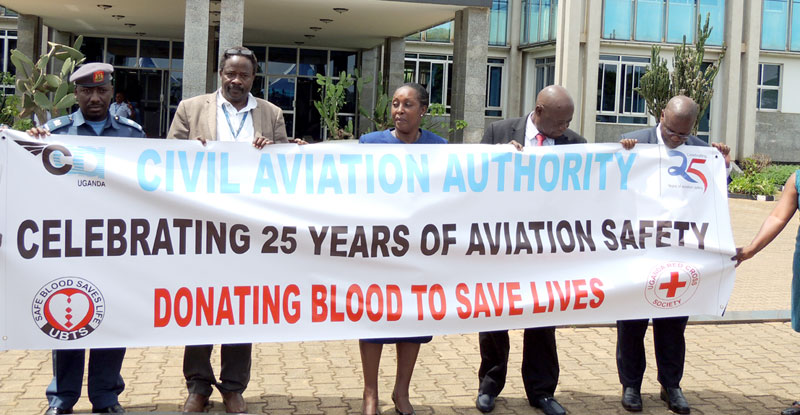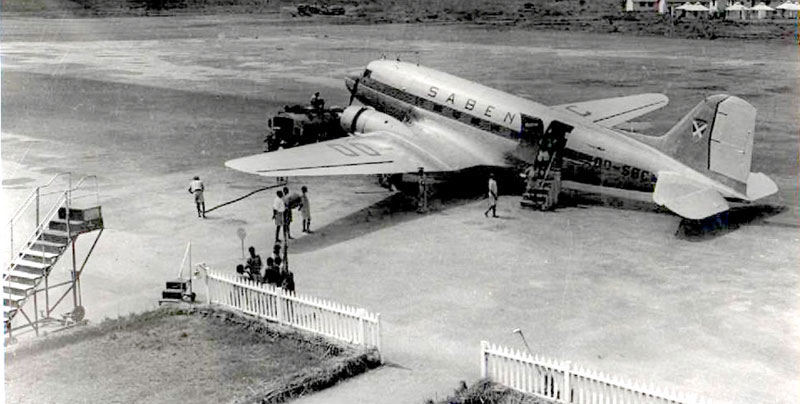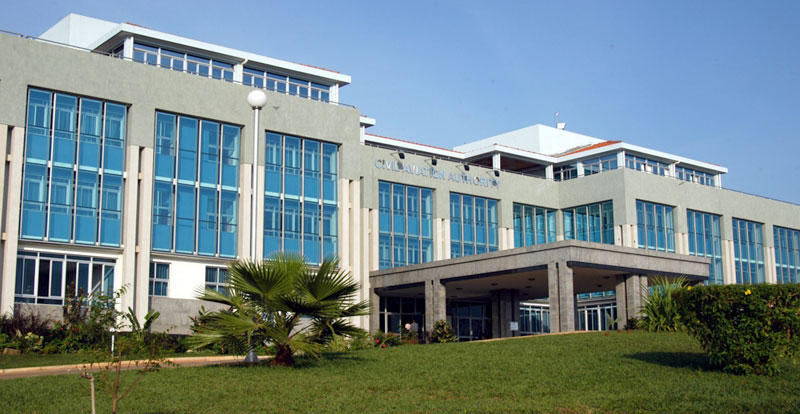Business
AVIATION WEEK – CIVIL AVIATION AUTHORITY CELEBRATES 25 YEARS
FLIGHT THROUGH THE TIMES

Entebbe Municipality MP Tumusiime joined CAA’s top Management and staff to launch the blood donation drive MP Tumusiime donating blood

The beginnings: Sabena was one of the very first civilian operated aircrafts to connect Uganda to the world using Entebbe airport
More than a century ago, the world was a very different place. Transportation was making strenuous steps that were to see the world a changed place.
The internal combustion engine was invented in the late 19th century, unveiling possibilities of motive force. The automobile was to replace the horse, and later, the steam engine which was the primary means of transport traversing long overland distances.
There was a more dramatic invention by 1903 – the aeroplane. The pioneering example of the two brothers, Orville and Wilber Wright saw human kind take to the skies. They started in frail craft.
Soon however, they developed sturdy and reliable machines that shattered the long-standing challenges of distance and time. Millions of people in Asia and Europe were using steamship to foster trade and expand their colonial dreams.
ENTER AFRICA
Africa largely remained undisturbed by the technological advancements in aviation. Much of the continent was under colonial rule. The first flight attempts to cross the African continent were futile. A number of them crashed on the continent due to undeveloped technologies required for the long haul flights.
The 1940s saw the face of air travel change, with the flying boats that flew to most of Africa disappearing. The war-time land-operating aircraft gave way to new airlines designed for commercial purposes. The earliest simmerings of flight for political independence in Africa had begun.
The colonial state was aware of the presence of thousands of war veterans on the continent. It became necessary to develop aeronautical infrastructure that would facilitate quick movement of colonial troops to quell any riots in the colonies.
Africa was witnessing the first efforts to establish airports at locations strategic to the colonial masters. The airports were located near the colonial administrative centres.
UGANDA JOINS THE FRATERNITY
In 1947 Entebbe peninsula rumbled with earth moving equipment to prepare the country’s gateway to the world- Entebbe International Airport.
Major infrastructure developments followed over the years. A national aerodromes network was established for domestic flights, starting with an airstrip at Kololo in Kampala.
However, the political turbulence in the subsequent years and the breakup of the East African Community, in 1977, left the country’s aeronautical infrastructure in dire state.
By 1986 the air transport industry in Uganda was in a discreditable form. The aeronautical infrastructure such as taxiways, runways, air navigation equipment, communication and surveillance equipment were operating below the recommended standards.
International airlines had shunned Entebbe Airport over safety and security standards, resulting in declining passenger traffic. Only 9 airlines were flying to Entebbe Airport by 1986. Annual international passenger numbers dropped to 118,000travelers and cargo declined to a paltry 5200 metric tonnes.
Besides, airport staff were demoralized due to lack of training and poor pay. Confusion in the management and control of the civil aviation industry was reigning high.
Airport operations were under a disaggregated system. The Ministry of Finance was handling customs and revenue collection. Ministry of Works was in charge of infrastructure; Ministry of Internal Affairs was controlling Immigration while security of the Airport was provided by a cocktail of security outfits.
The revenue realized from the airport would not be ploughed back to improve aeronautical infrastructure, leading to its dilapidation.
As a result, Uganda was facing isolation by the global air transport industry. With the national carrier, Uganda Airlines, registering losses, a quick solution was needed.
In 1991 the National Resistance Movement (NRM) government took a bold step and established the Civil Aviation Authority (CAA) with a mandate to revamp the air transport sub-sector.
The CAA was to operate on commercial principles, be self-sustaining and promote the safe and orderly growth of civil aviation in and outside the country.
The Authority was not immediately capitalized, posing big challenges to redirecting the basics such as restructuring the historic set up, including staff re-skilling and re-orientation.
The formative years (1991 – 95) witnessed resistance to change by the existing staff who feared for their employment and a suspicious future. Soon however, logic prevailed over resistance. The desired turn-around began in earnest.
The Danish and Spanish governments gave support to Uganda worth US$52 in 1992, to revamp Entebbe Airportaeronautical infrastructure and equipment.
The funding support caused resurfacing of Runway 17/35, and the Taxi ways. It also refurbished passenger facilities and caused upgrade of the Communication, Surveillance and air navigation and control equipment.
The industry responded. International Airlines regained confidence in the safety and security of aviation operations in the country. The turn around registered significant growth in both passengers and cargo. With operators confidence on the upswing, CAA was faced with ever-growing demand for better services. The tide and the times had, in reality, changed.
CAPACITY BUILDING PHASE
Following completion of the rehabilitation and refurbishment of some facilities at Entebbe Airport between 1991 and 2001, the CAA embarked on capacity building.
A study carried out in 2001 by an American Transportation Consultancy firm LPA, to identify strategies to develop the airport made findings and recommendations in a Master Plan that CAA adopted in 2002.
The study recommended expansion of the Arrivals and Departures areas, construction of a Domestic Operations passenger terminal, a modern Cargo Centre with capacity to handle 100,000 metric tones annually.
The old air traffic control management radar was recommended for replacement. A comprehensive training programme for staff was also strongly expressed.
Limited works started with the expansion of the Arrivals Hall in 2006 to provide better and hassle-free Immigration and Customs services. Modern longer baggage conveyor belts were installed to smoothen the baggage reclaim process.
Besides enlargement of the check-in area, the Departure facilities had a Departing Passengers Handling System (DPHS) installed to expedite the formalities.
Aircraft parking capacity was boosted with construction of a new 60,000 square feet apron. Entebbe Airport can now pack 60 medium-size jets at its four aprons. The expanded apron accommodated all the CHOGM aircraft in 2007.
An ultra-modern VVIP Terminal was constructed, enhancing the country’s ability to receive several State guests simultaneously. An Air Traffic Control radar was installed in October 2007, enhancing efficient management of Uganda’s airspace.
As is the norm, improved airport facilities and services attract new air operators who in turn increase air traffic to the country. This explains why Uganda’s exports to world markets by air recorded an impressive 24% annual average growth for the period 2008 to 2012.
An automated car-parking management system was installed in 2010 to ease vehicle movements in and out of the airport. The long term plan is to construct a storied parking to accommodate more vehicles.
Under the short-term phase, Immigration Counters were increased from 4 to 14. Two Passenger Boarding Bridges were installed and five security watch towers erected at the airport to enhance surveillance.
Due to the infrastructural improvements, the international passenger traffic at Entebbe Airport increased from 118,000 by 1991 to 1.4 million by December 2014. Airlines operating to Entebbe increased from 9 in 1991 to 17 in the same period, while staff strength grew from 320 to 1028 by the turn of 2015.
However the transformation created capacity challenges, prompting a review of the 2002/2022 master plan. The Authority, working with the International Civil Aviation Organization, procured a Consultancy Firm, Ms INECO from Spain to carry out a study for the Uganda Civil Aviation Master Plan. The 20-Year Master plan was launched in January 2015 and is currently under implementation.

Entebbe Municipality MP Tumusiime joined CAA’s top Management and staff to launch the blood donation drive MP Tumusiime donating blood
Comments


























